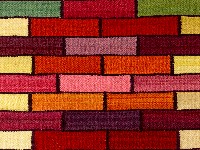Dear Readers:
Welcome to the Spring 2016 Edition of the Turkey Red Journal. I have just returned from Boise, Idaho, where I was one of a two-person team asked to judge the latest submission to the Handweavers Guild of America's COE (Certificate of Excellence) in Dyeing. It reminded me of all the work it took to complete my Level I and Level II in Dyeing. It also reminded me how invaluable the process was and the level of skills and knowledge I acquired by taking the time to complete the required written and dyeing exercises and color matching. The Handweavers Guild of America biennial Conference, Convergence, will be in Milwaukee this summer. They will have an informal seminar about the COE on Thursday, August 4. Check out this link for more information on the COE in Dyeing (https://www.weavespindye.org/certificates-of-excellence).
I will be showing two of my recent rugs at Convergence: Schulenberg Prairie in the Mixed Bag exhibition and Lurie Garden Pathway in the COE exhibition.
Planting season has arrived finally. We had a cold Spring in Chicago, which delayed planting of seeds that require warm soil. I have Cota seedlings started inside almost ready to plant and a new addition to the garden this year, Common Rabbitbrush. Last year, I tried geminating seeds that I purchased online, without any success. This year, Glenna Dean (TRJ Volume 15, Issue 1) sent me seeds she collected last fall. So far, I have at least 14 plants as starts. I got interested in trying Rabbitbrush after doing a dye and weaving project for the American Girl Company. Hopefully, I will be able to report success with this new addition to my dye garden in the Fall.
We have two submissions for this issue of the Turkey Red Journal. Jane Porter, a fashion designer and descendant from generations of Armenian weavers and dyers, figured out how to program a Miele washing machine to mordant and dye fabric and yarn. Jane's original research has helped many other natural dyer businesses. I was fortunate to meet Jane many years ago at a natural dye conference. There I purchased from her a beautiful naturally dyed and printed jacket that I still wear today.
Amy Taylor is a natural dye textile artist living in Chicago. For this issue, Amy co-wrote an article with Charles E. Taylor titled "Art at the Edge of Chaos: Shibori and Indigo". In this article, they explore the overlapping of art and science and its relationship to the patterns created by the shibori process. For all of us who have used and studied historical dye practices, this article gives us another way of looking at the creative process.
This Fall, I will be teaching a two day "Indigo Resist Dyeing Workshop" at the Chicago Botanic Garden. The workshop is held a beautifully equipped science lab that gives students ample space and equipment to learn and explore. For more information go to http://www.chicagobotanic.org/education/botanical_arts.
We have moved to an open submission policy for articles, artwork, exhibit notices and reviews for for upcoming issues. We are interested in featuring dyers from around the world, so don't hesitate to submit your ideas for articles. Send your submissions to madder@comcast.net.
Back issues of the print version of the TRJ are still available for purchase. Contact me directly for further information. Please keep sending in your thoughts and suggestions. We appreciate all your comments.
If you are not currently on the TRJ new issue notification mailing list and would like to receive notification when the new issue is online, please send an email to madder@comcast.net. Your email address will not be shared with others.
As always, a special thanks to Bob Feldman, our copy editor and webmaster for all his hard work.
Pamela FeldmanEditor and Publisher
www.pamelafeldman.com
 Turkey Red Journal
Turkey Red Journal
